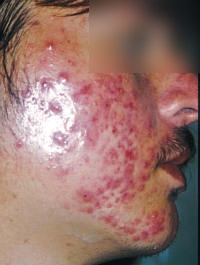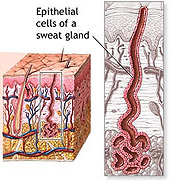 Clinical
note: Sebaceous glands become much more active after puberty and
can become affected causing acne vulgaris. The increased build-up of
sebum and dead cells leads to blocked ducts/hair
follicles resulting in small white lesions (comedones) that can be
sites of bacterial infection. The disease is normally self-limiting, but comedones can become sites of bacterial infections. Sometimes there
is marked scaring left in the wake of the inflammation. Clinical
note: Sebaceous glands become much more active after puberty and
can become affected causing acne vulgaris. The increased build-up of
sebum and dead cells leads to blocked ducts/hair
follicles resulting in small white lesions (comedones) that can be
sites of bacterial infection. The disease is normally self-limiting, but comedones can become sites of bacterial infections. Sometimes there
is marked scaring left in the wake of the inflammation.
On these two slides of H&E and trichrome
stained skin (sample
1, sample 2) identify:
- Secretory portions and
darker-staining ducts of merocrine (“eccrine”) sweat glands.
- Look for
myoepithelial cells surrounding
the secretory units.
- In the ducts, note the unusual
stratified cuboidal epithelium lining the ducts and the lack of
myoepithelial cells.

Examine the next two slides for apocrine
sweat glands (sample
1, sample 2).
- Compare the lumen size and overall
histological appearance of apocrine sweat glands to the more
common merocrine/eccrine sweat glands.
Try this
short self-assessment
quiz to see what you've learned.
Next is the
cartilage and bone. |